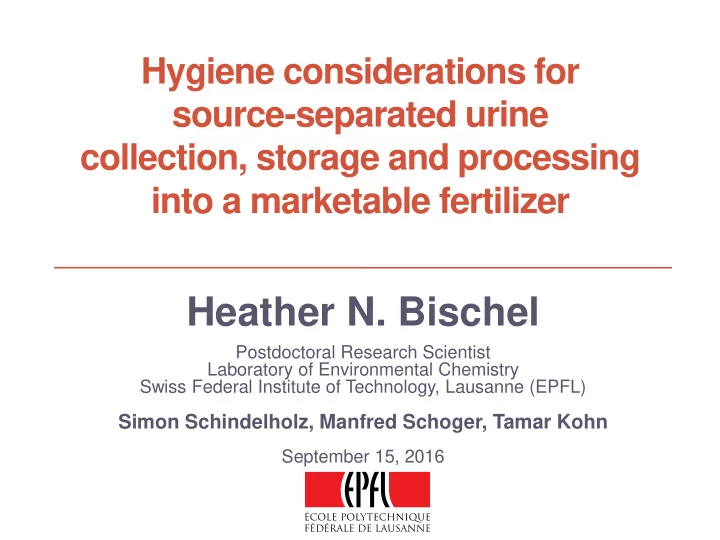

Hygiene considerations for source-separated urine collection, storage and processing into a marketable fertilizer Heather N. Bischel Postdoctoral Research Scientist Laboratory of Environmental Chemistry Swiss Federal Institute of Technology, Lausanne (EPFL) Simon Schindelholz, Manfred Schoger, Tamar Kohn September 15, 2016
Urine separation & Struvite production Kwazulu- Natal province Population: 3.5M >80K Urine-Diverting Dry Toilets Durban (UDDTs) in rural/peri-urban areas Struvite production: Add Mg 2+ , gentle mix, Valorisation of Cotton bag Filters Urine Nutrients in Africa MgNH 4 PO 4 ·6H 2 O (VUNA) Drying outdoors under cover 2
Hygiene Considerations 1g of fresh feces from an infected person can contain: ~10 6 viral pathogens 10 6 -10 8 bacterial pathogens 10 4 protozoan cysts or oocysts 10 – 10 4 helminth eggs Feachem et al, 1983 Source-separated urine is not sterile! Human pathogens detected in source-separated urine in Durban Diarrheal Human Bacteria viruses E.g.,: E.g.,: Shigella spp. , Rotavirus, Vibrio spp., Adenovirus, E. coli 0157:H7 Hepatitis A Virus Bischel et al, Wat. Res. 2015 3
Overall Objectives Characterize and optimize hygiene of urine storage and recycling Pathogens: Fertilizer Urine Struvite Production Excretion in application Storage & Drying feces / urine 1. Which hazards 2. How can we mitigate them? 3. Health risk are there? Inactivation Kinetics and Mechanisms implications? Challenges • Anticipate short-term urine storage for process scale-up or in dense locations • Which microbial targets to evaluate? Pathogen indicators and in situ bacteria • Manual struvite production in the field: Variable temperature and humidity 4
Inactivation Potential During Urine Storage BACTERIA: VIRUSES: e.g., E. coli and Salmonella e.g., C. perfringens spores: e.g., Rotavirus Slower inactivation Rapid die-off T 90 ~ 35 d Little to no reduction T 90 < 5 d at ~20 ° C at 20 ° C, 1:2 dilution ( Höglund , Stenström et al. 1998; Vinneras et al. 2008; Schonning 2001; Höglund, Ashbolt et al. 2002. Decrey et al. 2015, 2016) and others Inactivation depends on: • Organism (e.g., gram negative/positive bacterium; viral genome type) • Urine storage temperature • Ammonia concentration (urine dilution and storage conditions) • pH (ammonia speciation) Viable bacteria present after long-term storage And even urine treatment (Lahr et al, 2016) Inactivation during fertilizer production important after short-term urine storage
Inactivation during Struvite Precipitation & Drying Laboratory-made Struvite Cake • • Evaluate: Inactivation of virus and helminths during • Retention of bacteria in controlled struvite drying struvite cake ↑ inactivation with ↓ moisture content • Bacteria inactivation in ↑ inactivation with ↑ temperature lab (controlled) and field (Decrey et al . Wat. Res. 2011) • Degradation of struvite with T > 55 ˚ C • How to increase inactivation without heat treatment? 6
Methods: Bacteria Inactivation during Struvite Precipitation & Drying Targeted health-relevant bacteria: Heterotrophic plate counts: Salmonella typhimurium Enterococcus spp. Total viable bacteria by flow cytometry: Struvite 1000 1000 (Dead) 100 100 (Live) FL3 (Red) FL3 (Red) 10 10 ~10 10 viable bacteria 1 1 per gram of struvite! 0.1 0.1 0.1 0.1 1 1 10 10 100 100 1000 1000 7 FL1 (Green) FL1 (Green) 1600 1600
In situ measurements by Flow Cytometry 35˚C/40 % RH 0,5 12 Total Live Cells: Log C 0 Dead 11 (Counts/g ww) -0,5 Log C/C 0 10 -1 9 R² = 0,9186 -1,5 Live 8 -2 7 -2,5 3 4 5 6 7 -3 Heterotrophs: Log C 0 20 40 60 (CFU/g ww) Time (hrs) (Dead) (Live) FL3 (Red) FL3 (Red) FL3 (Red) 0 hrs 24 hrs 48 hrs FL1 (Green) FL1 (Green) FL1 (Green) 8
S. typhimurium Isothermal Struvite Drying High Relative Humidity Low Relative Humidity 1 1 0 0 -1 -1 High Humidity Low Humidity Log C/C 0 Log C/C 0 p > 1 -2 p < 1 -2 (Shoulder) (Tailing) -3 -3 -4 -4 -5 -5 0 200 400 600 0 200 400 600 Time (hrs) Time (hrs) Weibull Model: Distribution of resistances to inactivation • Tailing can result from, e.g.: log10(C) = log10(𝐷 0 ) − (𝑢 • Reduced probability of lethal hit δ) 𝑞 • Evaporative cooling at low humidity • Shape param. (p) captures tail or shoulder • Dehydration tolerant subpopulation • δ is the time for first-decimal reduction Retention of moisture for continued inactivation (followed by desiccation) 9
In situ Heterotrophic Bacteria Inactivation Controlled Lab Conditions Field Conditions 2 2 eThekwini Batch Nylon Filters Swiss Batch 1 Cotton Filters 1 1 0 0 Log(C/C 0 ) Log(C/C 0 ) -1 -1 -2 -2 -3 -3 -4 -4 -4 -3 -2 -1 0 -4 -3 -2 -1 0 Relative Moisture Content, Log( θ / θ 0 ) Log( θ / θ 0 ) Dynamic Field conditions: Oscillating temperature and relative humidity 10
Recommendations for inactivation of pathogens during struvite production Wet-heating for enhanced Soil Solarization inactivation of bacteria Addabbo et al 2010 Inactivation dependent on relative humidity Minimum temperature (35 ˚ C) required for helminth inactivation struvite degrades T > 55 ˚ C Desiccation: reduce moisture content for virus, helminth, & http://www.ipm.ucdavis.edu/ bacteria inactivation 11
Summary & Next steps Characterize and optimize hygiene of urine storage and recycling Pathogens: Fertilizer Urine Struvite Production Excretion in application Storage & Drying feces / urine 1. Which hazards are there? 2. How can we mitigate them? Source-separated urine is not sterile! Struvite Production • Contains fecal pathogens – • Bacteria retained in filtered struvite including persistent viruses • Field inactivation consistent with lab • Recommend: Personal protective • Recommend: initial retention of moisture equipment; sealed storage followed by desiccation Quantitative microbial risks assessment: during urine collection, handling and struvite production 12
Acknowledgements Funding: US and Swiss NSF • Tamar Kohn, Laboratory of Environmental Chemistry Bill & Melinda Gates • Kai Udert & Bastian Etter, Eawag/VUNA Foundation • Teddy Gounden, EWS Field staff Rotary Foundation • Chris Buckley, Sara Rhoton, Nicola Rodda, UKZN EPFL, EWS and Eawag • Simon Schindelholz, Manfred Schoger, Loic Decrey Contact Info After April 2017: Heather Bischel, Asst Prof University of California, Davis hbischel@ucdavis.edu
Recommend
More recommend